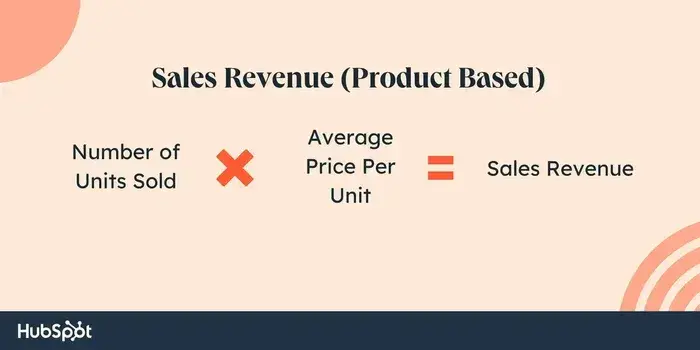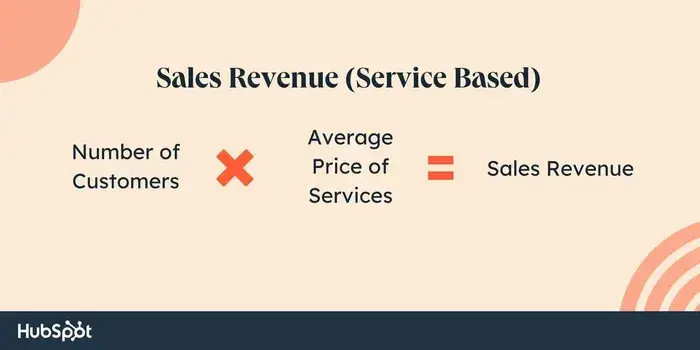Despite not having a sales quota (thankfully!), I realized understanding the concept of sales revenue was a must to create impactful content, and I got on to my research.
In this blog, I’ll be distilling everything I’ve learned about sales revenue and using it as a tool for business growth.
Table of Contents
- What is sales revenue?
- Revenue vs. Sales
- Why is sales revenue important?
- What are the types of sales revenue?
- How to Calculate Sales Revenue [+Formulas]
- Bottom Line: Mastering Sales Revenue Pays Off
What is sales revenue?
Sales revenue is a company's income generated through the sale of goods or services. The figure is usually reported for a fixed period — generally by month, quarter, or year.
Of course, I needed to dig deeper than a simple sales revenue definition. Because at first, I’ll admit I was confused. I wasn’t sure whether revenue and sales were the same thing, as I heard many sales professionals use the terms interchangeably in casual conversations.
However, I learned that they’re not identical. Revenue is the broader term, and knowing how to differentiate between the two is essential.
Revenue vs. Sales
Sales is the income a business generates by selling its goods and services. Meanwhile, revenue is a business’s income from all sources, including sales.
For example, a company can have $10 million in sales but $12 million in revenue if nonoperating income totals $2 million.
In other words:
- Sales, whether gross or net, include the proceeds from selling core products or services.
- Revenue, on the other hand, includes all the money a company takes in, including non-operating income from activities outside the core business operations.
So, revenue may come without sales, but all sales are inherently revenue.
Why is sales revenue important?
Sales revenue is the first metric reported on an income statement, and it’s the lifeblood of any business. Here are some top reasons why I think it matters.
Indicates Business Health
Sales revenue directly measures how well a product or service is performing in the market. Consistently high or growing sales revenue indicates strong customer demand and market fit. On the contrary, declining sales revenue signals potential issues a business might want to examine.
Guides Business Strategy
In my interactions, I saw how sales revenue forms a baseline to influence key decisions like budgeting, hiring, and resource allocation. It’s the foundation that most leaders abide by for setting realistic goals and determining where to invest for business growth.
Measures Sales Team Performance
I can vouch for this: Revenue is the ultimate performance metric for sales teams. After all, what matters to a business is not just closing deals but also ensuring those deals translate into meaningful income.
Attracts Investors and Stakeholders
Strong sales revenue signals a business's stability and growth potential. With good sales revenue numbers, I’ve seen how companies appear more attractive to investors and other external stakeholders.
Feeds Into Profitability
While sales revenue isn’t the same as profit, it’s a crucial first step. Without sufficient revenue, you cannot easily cover operating costs. Substantial sales revenue raises the chances of profitability, and without it, generating profit becomes impossible.
Supports Long-Term Growth
I’ve also seen that sustainable sales revenue fuels business expansion. It provides the resources needed to invest in new products, markets, and technologies to stay competitive.
These benefits make one thing clear — there is a connection between revenue and net income for your business. But if you look at an income statement, you’ll find two types of sales revenue. Which one do you use to ascertain what? Let me shine a spotlight on that.
What are the types of sales revenue?
Gross and net sales revenue are two types of sales revenue. Each has its purpose, impact, and calculation method. Let’s start by looking at their definitions.
- Gross sales revenue is the total of all sales of goods and services, excluding adjustments like returns, discounts, or allowances. This figure indicates a business’ ability to sell its products or services but doesn’t necessarily demonstrate its ability to generate profit.
Note: The formulae and examples discussed below pertain to gross sales revenue.
- Net sales revenue is gross sales revenue adjusted for any returns, discounts, or allowances. This metric more accurately represents a company's cash flow from customers and demonstrates its ability to generate profits.
Dig Deeper: For more on gross versus net sales and how to calculate them, check out this post.
Now, let’s move on to the sales revenue calculations.
How to Calculate Sales Revenue [+Formulas]
First, a tidbit I learned: You calculate sales revenue differently depending on whether the company sells products or services. However, I’d like to emphasize that the underlying concept remains the same in either case.
Let me explain the formula with an example for each.
Formula: Calculating Sales Revenue for Product-Based Companies
To calculate sales revenue for your product-based business, you need to multiply the number of units sold by their average price.
Here’s the formula:
Sales Revenue for Product-Based Company = Number of Units Sold x Average Price

Example of Sales Revenue Calculation (Product-Based Company)
Suppose in September, a boutique handmade scrunchie company, Sunday Scrunch, has sold the following in a particular month:
- 100 medium blue scrunchies for $3.50/unit.
- 150 small cheetah-print scrunchies for $3.00/unit.
- 50 large neon orange scrunchies for $4.00/unit.
What’s their sales revenue for September? Let’s do some math.
- Small scrunchies: 150 sold x $3.00 = $450
- Medium scrunchies: 100 sold x $3.50 = $350
- Large scrunchies: 50 sold x $4.00 = $200
Next, add all of these values together.
- $450 + $350 + $200 = $1,000
Sunday Scrunch’s September sales revenue would be $1,000.
Formula: Calculating Sales Revenue for Service-Based Company
To calculate sales revenue for a service-based business, you need to multiply the number of customers catered to by the average service price.
Here’s the formula:
Sales Revenue for a Service-Based Company = Number of Customers x Average Price of Services

Example of Sales Revenue Calculation (Service-Based Company)
Let’s say Elite Consulting Services had 250 customers in September, and their average price of services was $20,000. What’s their monthly sales revenue?
Check it out as I calculate it for you:
Service-Based Sales Revenue = Number of Customers x Average Price of Services
- Number of Customers = 250
- Average Price of Services = $20,000
- 250 x $20,000 = $5 million
Elite Consulting Services’ September revenue would be $5 million. Not a bad month, I’d say!
Formula: Calculating Net Income from Sales Revenue
Now, sales revenue is the starting point for determining any company’s net income. Net income is the basis for business-critical calculations and reports, including earnings per share and cash flow statements.
You can start with your sales revenue to arrive at net income. Let me explain how.
- First, you must subtract the cost of goods sold from sales revenue to determine your gross profit.
Gross Profit = Sales Revenue - Cost of Goods Sold
- Next, subtract any depreciation and SG&A (selling, general, and administrative) expenses from gross profit to find the operating margin — also referred to as earnings before interest and taxes or EBIT. SG&A can include rent, utilities, marketing and advertising, salaries, and other operating costs.
Operating Margin (EBIT) = Gross Profit - Depreciation - SG&A
- The next step is to subtract interest expenses from the operating margin to find pretax income.
Pretax Income = Operating Margin (EBIT) - Interest Expenses
- Finally, you need to subtract taxes from pretax income to arrive at your net income.
Net Income = Pretax Income - Taxes
As you can see, sales revenue is the baseline for calculating net income and is essential to ascertaining a business’s health and planning its future.
Bottom Line: Mastering Sales Revenue Pays Off
After all this research, I can confidently say (and hope you’ll agree) that sales revenue is one of the most influential metrics in business analysis and forecasting. It’s no surprise that it dominates conversations from salespeople to management. After reading this article, I hope you understand sales revenue, how to calculate it, and how to use it to demonstrate results and strategize your growth.
Sales Metrics






![Sales Metrics: What to Track, How to Track, & Why [Expert Tips]](https://53.fs1.hubspotusercontent-na1.net/hubfs/53/sales-metrics.webp)





![Understanding Sales Variance [Formula + Examples]](https://53.fs1.hubspotusercontent-na1.net/hubfs/53/Sales%20Variance.png)